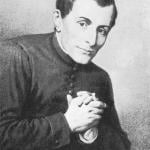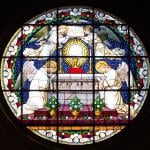to Stephen Prothero’s list of the 12 most influential US Catholics.
I agree with LarryD. For one thing, I would argue that Mother Angelica, incapacitated though she is, remains a massive influence, since her network is, after all, seen all over the globe.
When I was in Denver, I had the privilege of hearing John Allen speak (and getting to chat with him briefly). His talk was fascinating (as you’d expect) and one of the points he made was that Evangelical Catholicism is here to stay, both as a grass roots movement in the Church and as the driving agenda from Rome as well. He noted that American and First World Catholics tend to view everything through the lens of their local experience and so their narrative tends to be one of decline since the council. But he said that in the developing world and the global south, the Church has witnessed explosive growth (as in nearly 7000% percent growth–and no I did not accidently include an extra zero) since 1900:
The popular take on Catholicism these days tends to be that it’s a church in crisis. Rocked by sex scandals, bruising political fights and financial shortfalls, it seems to be hemorrhaging members — a recent Pew Forum study found there are now 22 million ex-Catholics in America, which would be the country’s second-largest religious body after what’s left of the Catholic church itself — as well as clustering parishes, closing institutions and struggling to hand on the faith to the next generation.
The overall perception is that this is an era of Catholic entropy — decline, contraction, things getting smaller.
Seen from global perspective, however, that’s just wildly wrong. The last half-century witnessed the greatest period of missionary expansion in the 2,000-year history of Catholicism, fueled by explosive growth in the southern hemisphere. Take sub-Saharan Africa as a case in point: The Catholic population at the dawn of the 20th century was 1.9 million, while by the end of the century it was more than 130 million, representing a staggering growth rate of 6,708 percent. Overall, the global Catholic footprint shot up from 266 million in 1900 to 1.1 billion in 2000, ahead of the overall rate of increase in world population, and is still rising today.
The dominant Catholic narrative of our time, in other words, is not decline but astronomic growth.
In other words, you are living in the middle of the greatest period of missionary success in the history of the Church. Are there setbacks and persecutions? Of course, the hostility you are seeing is due, not to the fact that the Church is a thing of the past, but to the fact that the Dragon is furious, for he knows his time is short.
This has everything to do with our call to bear witness to the faith as Americans. Why? Because the American Catholic Church remains a powerhouse of evangelical creativity, ferment and enterprise. We see all the infighting and struggle here in the States and elsewhere in the West (and that struggle is real and must be faced, as quislings like Sebelius or Catholics for a Free Choice demonstrate). But we should also count our blessings that organizations like, say, Catholic Answers have a global reach and their materials are copied and imitated by ardent evangelists in Africa (a shout out to Godwin Delali Adadzie is in order here).
In short, far beyond the influence of the people Prothero lists are the ordinary unheralded evangelists (like LarryD and countless other lay Catholics and priests and religious toiling in their spheres) who are helping evangelists abroad toiling in their spheres to make this the single most explosive period of growth in the Church’s entire history. Outfits like EWTN and Catholic Answers and other lay apostolates play a huge and largely unheralded role in that which goes unnoticed by people who think everything is in NY, DC, and LA. It’s rather like Christians who focused all their attention on Jerusalem in the first century and paid no notice to the work being done by some Johnny come lately named Saul of Tarsus. It would eventually prove that people from the woods of Gaul, the Iberian Peninsula and the British Isles would have some important gifts to give the Church. Here too we see that grace is dark matter and that “God chose what is foolish in the world to shame the wise, God chose what is weak in the world to shame the strong, God chose what is low and despised in the world, even things that are not, to bring to nothing things that are, so that no human being might boast in the presence of God.” (1 Cor 1:27-29)
When the real history of our time is written in some future age, the people we think important now will vanish in significance compared to some unknown and unsung schlub who may be, for all we know, toiling in a soup kitchen in Uganda at this hour and downloading a copy of Pillar Fire, Pillar of Truth to read aloud at his Bible study tonight.











